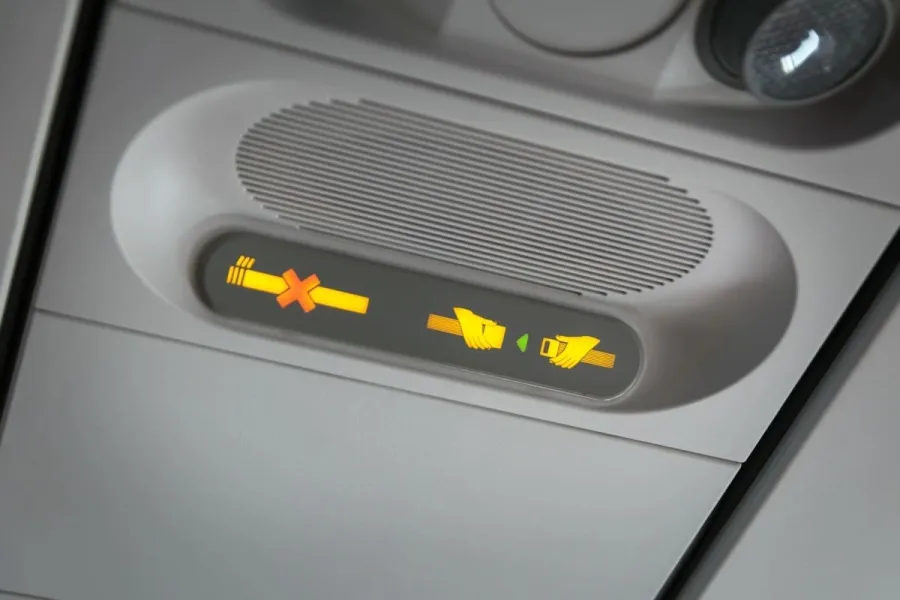Change language
Smoking on a plane: What you should know
February 10, 2025

Imagine stepping onto an airplane and seeing passengers casually lighting cigarettes, their smoke curling through the cabin as they settle in for a long-haul flight. Not too long ago, this was a common scene in aviation. Smoking sections were as much a part of air travel as the tiny bags of peanuts. However, today, the very idea feels unthinkable.
But why did smoking on planes vanish almost overnight?
What happens if someone defies this rule in modern air travel?
And are there still airlines that allow it in some form?
Smoking on airplanes: a history
As you settle into your airplane seat, perhaps you've noticed the no-smoking sign above your head or the obsolete ashtray in the armrest. But can you imagine a time when the cabin was filled with a haze of smoke and the lingering burn of nicotine?
In the early days of commercial aviation, smoking was not only allowed but it was also promoted. Airlines often had designated smoking areas, usually at the back of the plane. This was considered a norm, a part of the high-flying experience. By the 1970s, nearly half of all Americans were smokers, and it was common to light up at 30,000 feet. [1]
However, for non-smokers, this was less than ideal. The smoke would fill the cabin, creating an unpleasant environment and often causing discomfort or even health issues for those not partaking. Ventilation systems were hardly up to the task of clearing the air, and you can imagine the discomfort of sitting in a smoke-filled tube for hours on end.
The turning point came in the late 1980s and early 1990s when the health risks of second-hand smoke became undeniable. Various countries started introducing smoking bans on commercial flights, first on short-haul domestic flights, and then progressively extending to all flights.
The good this is that you can still bring a lighter on a plane.
Why are there still no-smoking signs and ashtrays on airplanes?
The no-smoking signs act as a visual reminder of the strict rules in place. Even though the ban on smoking is widely known, the signs play a crucial role in reinforcing the severity and importance of the rule.
Ashtrays, on the other hand, might seem counterintuitive. However, they are a critical safety precaution. They are there in case a passenger decides to ignore the smoking ban. The logic is simple: if someone does break the rules, the ashtray ensures that the cigarette butt can be disposed of safely, minimizing the risk of a potential fire.
Understanding the laws: smoking regulations on commercial flights
Most countries have implemented strict regulations prohibiting smoking on commercial flights. This includes both traditional cigarettes and, increasingly, electronic cigarettes (e-cigarettes) or vaping devices. The International Civil Aviation Organization (ICAO) discourages smoking on board aircraft as part of its safety and health guidelines.
Key National and Regional Regulations
United States: smoking has been banned on all domestic and international flights originating or landing in the U.S. since 2000 under the Federal Aviation Administration (FAA). This includes e-cigarettes.
European Union: smoking has been prohibited on all EU flights since the 1990s, and the ban extends to electronic devices.
Asia and the Middle East: many countries, including China and India, have adopted similar no-smoking policies on all flights.
Airport-specific rules
Smoking inside airports is also highly restricted, with designated smoking areas available in certain airports. These areas are typically separate from the main passenger lounges.
Are there any airlines that allow smoking?
Smoking on planes was common until the late 20th century, with many airlines even offering smoking sections. However, due to health risks, discomfort for passengers, and fire hazards, this practice was gradually eliminated.
No major commercial airlines allow smoking in-flight today. The only exceptions are some private charter flights, which may permit smoking if agreed upon by the passengers and operator. However, these instances are extremely rare and are subject to local regulations.
Penalties for smoking on a plane
Legal consequences:
- smoking in an airplane's cabin, restroom, or any non-designated area is illegal and considered a safety violation;
- penalties include: fines ranging from 500 Euros to 1000 Euros, depending on the jurisdiction and the severity of the offense;
- imprisonment in extreme cases, particularly if the act endangers the flight or other passengers.
Airline actions
Passengers caught smoking may be:
- subject to immediate detainment upon landing;
- placed on a no-fly list, banning them from future travel with the airline.
If a passenger is removed from a flight for smoking or tampering with smoke detectors, they forfeit their right to any denied boarding compensation, even if they are involuntarily removed. Airlines are under no obligation to rebook such passengers or cover additional expenses related to travel disruptions caused by their actions. This serves as a stark reminder of the consequences of breaking aviation rules.
Preventing smoking cravings on long-haul flights
Long-haul flights can be a challenging experience for smokers, as they are often required to spend many hours without a cigarette. As a smoker, you might wonder how you can manage those cravings during your journey.
Here are some effective strategies to help you overcome this hurdle:
- Use nicotine replacement products. These include nicotine gum, patches, or lozenges. Particularly on long flights, these products can be a lifesaver, providing a steady release of nicotine to your body, thus curbing your urge to smoke.
- Plan strategic stopovers. During these stopovers, you can take the opportunity to have a cigarette.
- Adjust your flight times so they do not coincide with your typical smoking times. So, if you are used to having a smoke after meals, book a flight that does not coincide with meal times.
- Distractions can be a highly effective way to manage cravings. This could involve activities like watching movies, listening to music, reading a book, or using the in-flight entertainment system. Learn how to choose the best seat on the plane and enjoy your flight!
Remember that quitting smoking, especially on long-haul flights, is as much a mental challenge as it is a physical one!
Smoking on board – What is the situation on a private jet?
When it comes to smoking on private jets, the regulations differ significantly from those of commercial flights. The rules are less rigid and more dependent on the discretion of the owner or operator of the aircraft.
You may find it surprising that smoking can be allowed on private jets, provided certain conditions are met, primarily surrounding employee protection rights. These rules mean that if even one crew member voices a complaint, smoking must be stopped immediately.
Let's consider a hypothetical scenario: You're a passenger on a private jet, the owner of which allows smoking on board. However, during the flight, one of the flight attendants expresses discomfort due to the smoke. In this case, despite the owner's policy, smoking would have to cease immediately.
However, there are exceptions to this rule. For instance, in smaller propeller aircraft used for short-haul flights, where the cockpit isn't physically separated from the passenger cabin, smoking remains prohibited. The safety of the crew and passengers is paramount, and in such situations, the risk of smoke interfering with the pilot's operation of the aircraft is too high.
Ready to fly with confidence? Make sure you’re fully informed about the do’s and don’ts of air travel. Bookmark this guide, share it with fellow travelers, and always check the specific policies of your airline before boarding. For more tips and insights into stress-free flying, explore our other travel guides and start your next journey on the right note!
Sources
[1] Cummings, K Michael, and Robert N Proctor. “The Changing Public Image of Smoking in the United States: 1964–2014.” Cancer Epidemiology Biomarkers & Prevention, vol. 23, no. 1, 1 Jan. 2014, pp. 32–36, pmc.ncbi.nlm.nih.gov/articles/PMC3894634/, https://doi.org/10.1158/1055-9965.epi-13-0798. Accessed 22 Jan. 2025.
More travel blog recommendations

Μετατρέψτε την καθυστερημένη, ακυρωμένη ή υπερκλεισμένη πτήση σας σε αποζημίωση έως και 600€!
Αποζημίωση για καθυστερημένη πτήση ακυρώθηκε
Επιστροφή χρημάτων για ακυρωμένη καθυστερημένη πτήση
Αποζημίωση πτήσης
©2025 AirClaim.com - Όλα τα δικαιώματα διατηρούνται Air Claim SA - Bdul. Pipera 1/Vi Bl. HYPERION TOWERS Et. 3 SP. BIR. 3 Cod 077190, Voluntari, Ilfov, Ρουμανία



















